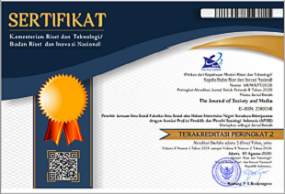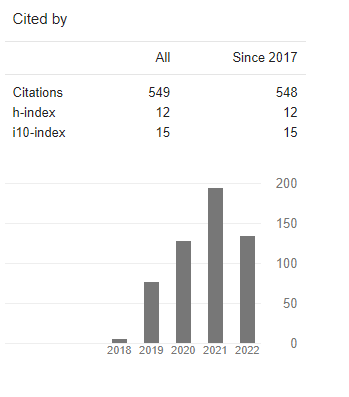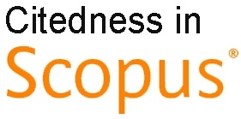Work from Home: Social Media, Virtual Meeting and the New Family Relationship
DOI:
https://doi.org/10.26740/jsm.v5n2.p285-310Keywords:
WFH, Multitasking, NegotiatingAbstract
The COVID-19 pandemic has actually forced people to work at home. Office activities outside the home can result in the transmission of COVID-19 to its workers. The government has taken a decision to minimize employee attendance at the office. Employees are encouraged to work at home (WFH), especially in groups vulnerable to infection. The house is turned into an “office space.” With the internet network, these employees are connected to each other. Although factually, this pattern is not a new thing because it has been carried out since the 2000s and is now becoming increasingly intensive. Through qualitative research with an ethnomethodological perspective, the results show that with this pattern, the house has become an encounter between public space and domestic space. This requires a strategy to manage roles in the home. Through in-depth observations and interviews, there were several important findings. First, there is a struggle for space in the house. Second, there is a transfer of stress from work to home. Third, there is a renegotiation of roles in the house, so as not to disturb family harmony. No less important, the community of users of social media and virtual meetings builds constructions of public and domestic space and time. The division of space and time in virtual space is also related to a person's role and social status when in the real world of work.
References
Aarts, Emile, Hein Fleuren, Margriet Sitskoorn, and Ton Wilthagen, eds. 2021. The New Common: How the COVID-19 Pandemic Is Transforming Society. Cham: Springer International Publishing.
Abdiraiymova, G. S., and D. K. Burkhanova. 2015. Social Structure of Society and Middle Class. Almaty: Al-Farabi Kazakh National University.
Bell, Daniel. 1988. The End of Ideology: On the Exhaustion of Political Ideas in the Fifties: With a New Afterword. Cambridge, Mass: Harvard University Press.
Bourne, Ryan. 2021. Economics in One Virus: An Introduction to Economic Reasoning through COVID-19. Washington, DC: Cato Institute.
Chung, Heejung, Hyojin Seo, Sarah Forbes, and Holly Birkett. 2020. Working from Home During the Covid-19 Lockdown: Changing Preferences and the Future of Work. Birmingham: University of Birmingham; University of Kent.
Chwieroth, Jeffrey M., and Andrew Walter. 2019. The Wealth Effect: How the Great Expectations of the Middle Class Have Changed the Politics of Banking Crises. 1st ed. Cambridge University Press.
FAHZU. 2020. Handbook of COVID-19 Prevention and Treatment. edited by T. Liang. Zhejiang: The First Affiliated Hospital, Zhejiang University School of Medicine.
Glassman, Ronald M. 1997. The New Middle Class and Democracy in Global Perspective. London: Palgrave Macmillan UK.
Hage, Jerald, and Charles H. Powers. 1994. Post-Industrial Lives: Roles and Relationships in the 21st Century. 4. Dr. Newbury Park, Calif.: Sage.
Hammersley, Martyn, and Paul Atkinson. 1986. Ethnography: Principles in Practice. Vol. 15. 3rd ed. Oxon: Routledge.
Harianto, Sugeng, Arief Sudrajat, and FX Sri Sadewo. 2007. E-Comerce. Studi Tentang Perubahan Pola Matapencaharian Dan Pola Interaksi Dalam Keluarga Di Surabaya Dan Sekitarnya. Surabaya: Universitas Negeri Surabaya.
Leicht, Kevin T., and Scott T. Fitzgerald. 2013. Middle Class Meltdown in America: Causes, Consequences, and Remedies. 0 ed. London and New York: Routledge.
Mayer, Kenneth H., and Hank Pizer, eds. 2005. The AIDS Pandemic: Impact on Science and Society. Amsterdam ; Boston: Elsevier Academic Press.
Nissanov, Zoya. 2017. Economic Growth and the Middle Class in an Economy in Transition. The Case of Russia. Cham: Springer International Publishing.
Republik Indonesia, Menpan RB. 2020a. SE Menpan RB No. 12 Tahun 2020 Tentang Penyesuaian Sistem Kerja Aparatur Sipil Negara Dalam Upaya Pencegahan Penyebaran COVID-19 Di Lingkungan Instansi Pemerintah.
Republik Indonesia, Menpan RB. 2020b. SE Menpan RB No. 50 Tahun 2020 Tentang Perubahan Kedua Atas Surat Edaran Menpan RB Tentang Penyesuaian Sistem Kerja Aparatur Sipil Negara Dalam Upaya Pencegahan Penyebaran COVID-19 Di Lingkungan Instansi Pemerintah.
Spradley, James P. 1980. Participant Observation. 1st ed. Forth Worth, Orlando: Harcourt Brace Jovanovich College Publishers.
Winston, Brian. 1998. Media Technology and Society. A History: From the Telegraph to the Internet. London and New York: Routledge, Taylor & Francis Group.
World Bank. 2020. Aspiring Indonesia. Expanding the Middle Class. Washington, D.C: World Bank.
Downloads
Published
How to Cite
Issue
Section
License
Copyright (c) 2021 The Journal of Society and Media

This work is licensed under a Creative Commons Attribution 4.0 International License.
 Abstract views: 723
,
Abstract views: 723
, PDF Downloads: 492
PDF Downloads: 492












